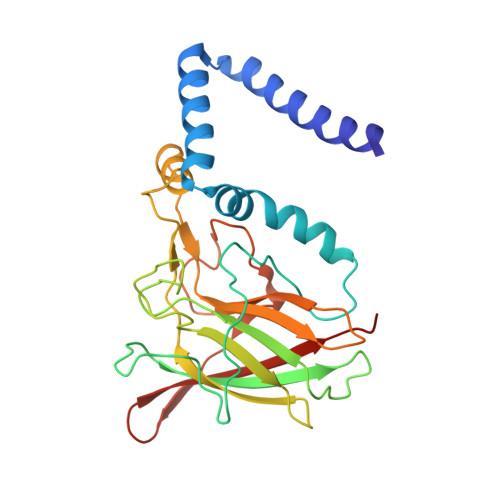Crystal structure of 3-chlorocatechol 1,2-dioxygenase key enzyme of a new modified ortho-pathway from the Gram-positive Rhodococcus opacus 1CP grown on 2-chlorophenol.
Ferraroni, M., Kolomytseva, M.P., Solyanikova, I.P., Scozzafava, A., Golovleva, L.A., Briganti, F.(2006) J Mol Biology 360: 788-799
- PubMed: 16793061
- DOI: https://doi.org/10.1016/j.jmb.2006.05.046
- Primary Citation of Related Structures:
2BOY - PubMed Abstract:
The crystal structure of the 3-chlorocatechol 1,2-dioxygenase from the Gram-positive bacterium Rhodococcus opacus (erythropolis) 1CP, a Fe(III) ion-containing enzyme specialized in the aerobic biodegradation of 3-chloro- and methyl-substituted catechols, has been solved by molecular replacement techniques using the coordinates of 4-chlorocatechol 1,2-dioxygenase from the same organism (PDB code 1S9A) as a starting model and refined at 1.9 A resolution (R(free) 21.9%; R-factor 17.4%). The analysis of the structure and of the kinetic parameters for a series of different substrates, and the comparison with the corresponding data for the 4-chlorocatechol 1,2-dioxygenase isolated from the same bacterial strain, provides evidence of which active site residues are responsible for the observed differences in substrate specificity. Among the amino acid residues expected to interact with substrates, only three are altered Val53(Ala53), Tyr78(Phe78) and Ala221(Cys224) (3-chlorocatechol 1,2-dioxygenase(4-chlorocatechol 1,2-dioxygenase)), clearly identifying the substitutions influencing substrate selectivity in these enzymes. The crystallographic asymmetric unit contains eight subunits (corresponding to four dimers) that show heterogeneity in the conformation of a co-crystallized molecule bound to the catalytic non-heme iron(III) ion resembling a benzohydroxamate moiety, probably a result of the breakdown of recently discovered siderophores synthesized by Gram-positive bacteria. Several different modes of binding benzohydroxamate into the active site induce distinct conformations of the interacting protein ligands Tyr167 and Arg188, illustrating the plasticity of the active site origin of the more promiscuous substrate preferences of the present enzyme.
- Dipartimento di Chimica, Università di Firenze, Via della Lastruccia 3, I-50019 Sesto Fiorentino (FI), Italy.
Organizational Affiliation:




















